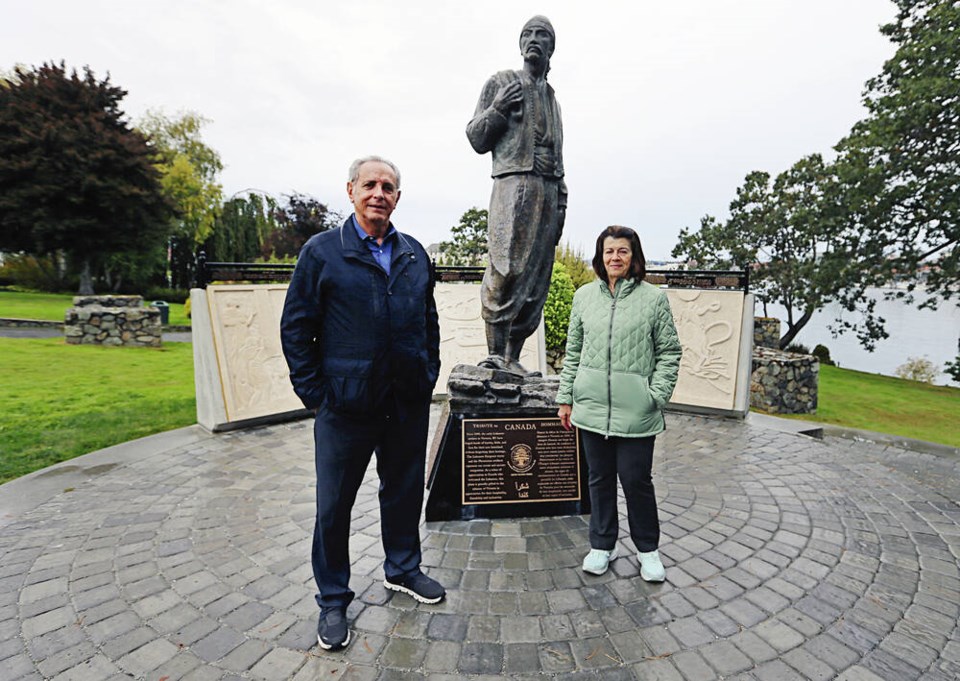The inauguration of the Lebanese Emigration Plaza in Victoria by the Lebanese-Canadian community today marks 135 years of B.C. immigration from Lebanon.
Nick Kahwaji, a B.C. honorary consul for Lebanon, said that the plaza, at Centennial Park near the Victoria Clipper terminal, is a gift to Victorians and represents the enduring appreciation and friendship between the two countries.
While the Lower Mainland now has a larger Lebanese-Canadian population, Victoria was chosen as the location for the plaza because of the capital’s historic significance, said Kahwaji, a dentist in Vancouver. Many early Lebanese settlers initially worked as peddlers in Victoria and in the forestry industry on Vancouver Island.
In 1888, brothers Abraham and Farris Ray were the first Lebanese to arrive in Victoria, working as itinerant peddlers, according to the World Lebanese Cultural Union.
The Lebanon Emigrant statue at the centre of the plaza was previously installed near the intersection of Douglas Street and Pandora Avenue.
Initially commissioned by the B.C. Council of the World Lebanese Cultural Union, it’s a replica of the statue that sits on Halifax’s waterfront and several other cities in the world that have prominent historical connections to the Lebanese diaspora.
The recently built plaza features depictions of early Phoenician immigration in the Mediterranean, carved in Lebanese granite, and a statue symbolizing contemporary Lebanese immigration, from a Mexican-Lebanese sculptor.
The project, in the works since 2009, only started making progress after Kahwaji made a personal appeal to then-mayor Lisa Helps, he said.
“Not only are we four brothers — four doctors — who want to say thank you, Canada, there’s 100,000 Lebanese who want to say the same to Canada,” said Kahwaji, recalling the conversation he had with Helps around 2016.
Georges Murr, founder of Ali Baba Pizza, was one of those keen to show his gratitude. The Murr family were major donors to the plaza.
Murr, a prominent Lebanese Canadian in Victoria, was a driving force for the plaza and his death in 2018 was a huge loss to the project, Kahwaji said.
While the plaza was officially approved by the city in 2017, the pandemic caused cost increases and delays. “We could not find people on the Island to work so we had to bring our staff from Vancouver to do the work,” Kahwaji said. “It cost us double.”
The plaza, inspired by the Phoenician-Roman hippodrome, was designed by Los Angeles-based architect Marie-Claude Fares, who also helped design the Centre for Trades Education and Innovation at Camosun College. The engineering firm for the project is RAM Consulting.
Kahwaji said that the plaza will serve as the future gathering place for B.C.’s Lebanese-Canadian community’s annual celebrations that occur every March. “Every family who had their grandparents, uncles, parents who died — they would bring a flower, put it over there and remember the early pioneers of the Lebanese who came to Victoria.”
The inauguration ceremony for the Lebanese Emigration Plaza will begin at 12:30 p.m. and is expected to feature appearances from representatives of B.C. government and the City of Victoria. Fadi Ziadeh, the Lebanese ambassador in Ottawa, will be representing Lebanon.
Honorary consuls for Lebanon from Vancouver, Calgary and Halifax will attend, as well as the Lebanese ambassador from Washington, D.C., Kahwaji said.
The Lebanese community in Canada numbers between 200,000 to 400,000 and is one of the largest Arab-Canadian populations in the country, according to Global Affairs Canada.



